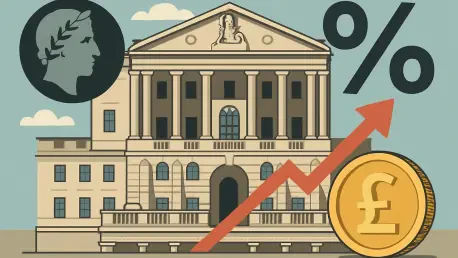On a pivotal day for UK financial markets, the Bank of England (BoE) made the significant decision to cut its benchmark interest rate by 25 basis points to 4.00%, announced on August 7. This move, coming after a contentious voting process among committee members, has stirred varied reactions across economic landscapes, with the British pound strengthening against the dollar while the FTSE 100 index experienced a notable decline of 0.7%. Such a divergence between currency gains and equity losses raises questions about the underlying economic currents and the BoE’s strategic intent. Amidst this, global markets present a contrasting picture, with European indices rising and US futures signaling optimism. Additionally, emerging trade disruptions due to new tariffs add further complexity to the financial environment. This article explores the motivations behind the BoE’s rate reduction, the reasons for the FTSE 100’s dip, and the broader implications of these intertwined economic factors for markets and businesses alike.
Decoding the Bank of England’s Monetary Policy Shift
The BoE’s recent decision to lower interest rates was far from straightforward, requiring two rounds of voting to reach a narrow 5-4 majority in favor of the 25 basis point cut from 4.25% to 4.00%. Initially, the committee was split, with four members supporting the reduction, four advocating to maintain the existing rate, and one pushing for a more aggressive 50 basis point slash. This internal division underscores the challenging economic conditions the UK faces, where stimulating growth must be carefully balanced against the risk of persistent inflation. The central bank emphasized a “gradual and careful” approach, indicating that future policy adjustments will hinge on clear evidence of disinflationary trends and other economic indicators. Such caution suggests a deep awareness of the delicate tightrope between fostering recovery and preventing price pressures from spiraling, reflecting the complexity of the current monetary landscape in the UK and the BoE’s intent to avoid rash decisions.
Analyst perspectives shed further light on the murky path ahead following this rate cut. Experts like George Brown from Schroders highlight that while the reduction was widely anticipated, the economic outlook remains uncertain due to conflicting signals from labor market data, growth metrics, and inflation rates. There’s a consensus that the BoE is unlikely to pursue aggressive easing in the near term, as doing so could risk reigniting inflationary concerns at a time when economic recovery is still fragile. Instead, the focus appears to be on incremental adjustments, with the central bank poised to gather more data before committing to further cuts. This measured stance aligns with broader concerns about global economic stability, where domestic policy must also account for international headwinds. The rate cut, therefore, represents not just a response to immediate pressures but also a strategic positioning for navigating an unpredictable future, balancing short-term relief with long-term economic health.
Analyzing the FTSE 100’s Decline Amid Market Divergence
Despite the British pound appreciating to $1.3431 from $1.3343 following the BoE’s announcement, the FTSE 100 index took a noticeable hit, falling 0.7% or 64.76 points to close at 9,099.55. This downturn was largely driven by significant declines in major constituents such as AstraZeneca, Rolls-Royce, and Barclays, many of which were impacted by going ex-dividend—a corporate event that typically exerts downward pressure on stock prices as shareholders lose dividend entitlements. This technical factor compounded the broader market unease surrounding the implications of the rate cut, suggesting that investors may be wary of the UK’s economic trajectory despite the BoE’s efforts to stimulate growth. Meanwhile, the FTSE 250, representing mid-cap companies, managed a slight uptick of 0.1%, indicating a fragmented response across different segments of the UK equity market to the central bank’s policy shift.
In stark contrast to the UK’s primary index, international markets displayed a more optimistic tone on the same day. European bourses like the CAC 40 in Paris surged by 1.2%, while Frankfurt’s DAX 40 climbed 1.6%, reflecting broader confidence among continental investors. Across the Atlantic, US futures also pointed to a positive start, with expectations of a 0.6% rise in the Dow Jones Industrial Average and a 0.9% gain in the S&P 500. This global divergence raises intriguing questions about why the FTSE 100 underperformed compared to its peers. It appears that international investors may perceive the UK’s challenges as more localized, tied to specific corporate actions like ex-dividend dates or sector-specific vulnerabilities, rather than a systemic loss of faith in the wake of the BoE’s monetary easing. Such contrasting market reactions highlight the nuanced interplay between domestic policy decisions and global investor sentiment.
Global Trade Challenges and Their Impact on UK Markets
Adding to the complexity of the UK’s financial environment, significant disruptions in global trade are emerging as a critical concern, potentially influencing the FTSE 100’s lackluster performance. Under the Trump administration, new tariffs ranging from 10-20% have been imposed on various businesses, with Switzerland facing an exceptionally high rate of 39%, the steepest among developed nations. A particularly striking 100% tariff on semiconductor imports aims to boost US manufacturing, though exemptions for products containing chips provide some relief. These protectionist measures are reshaping supply chains and inflating cost structures for companies worldwide, including those listed on UK indices with substantial international exposure. For investors, this introduces additional uncertainty, as the long-term effects of such trade barriers could dampen corporate earnings and economic growth, further pressuring equity markets like the FTSE 100 on days of significant policy shifts.
The uneven impact of these macroeconomic trends is vividly illustrated through individual company performances within the UK market. On the FTSE 250, Morgan Advanced Materials saw its shares plummet 14% after reporting a staggering 47% drop in pretax profit, attributed to weak market conditions and adverse foreign exchange movements. Conversely, Harbour Energy enjoyed a 14% surge, buoyed by a $100 million share buyback, an enhanced interim dividend, and upwardly revised production guidance following a strategic acquisition. These contrasting outcomes underscore how global trade tensions and domestic monetary policy ripple through the market in disparate ways, affecting firms based on their sector, strategy, and exposure to international dynamics. Such variability likely contributed to the FTSE 100’s volatility, as investors grapple with both the BoE’s rate cut and the broader uncertainties posed by a shifting global trade landscape, creating a challenging environment for consistent market gains.
Looking Ahead: Navigating Economic Uncertainty
Reflecting on the events of August 7, the BoE’s decision to trim interest rates to 4.00% marked a calculated step toward easing monetary constraints, yet it revealed deep-seated uncertainties within the UK’s economic framework. The split vote among committee members and the subsequent market reactions—with the pound gaining but the FTSE 100 faltering—highlighted the intricate balance between policy actions and investor perceptions. Global trade disruptions, driven by aggressive tariff policies, added another layer of pressure, while individual corporate performances painted a fragmented picture of resilience and struggle. These factors combined to create a day of mixed signals, where the intended stimulus of a rate cut clashed with broader concerns about economic stability and international headwinds, ultimately contributing to the FTSE 100’s decline.
Moving forward, the path for UK markets and policymakers appears fraught with challenges that demand careful navigation. Stakeholders should closely monitor upcoming economic data, such as US jobless claims and domestic inflation figures, to gauge the potential for further rate adjustments. Companies exposed to global trade must strategize around tariff impacts, seeking diversification or renegotiation opportunities to mitigate costs. For investors, a focus on sector-specific trends and corporate fundamentals could offer clarity amid market volatility. The BoE’s gradualist approach suggests that flexibility will be key, with future decisions likely to adapt to evolving indicators. As the financial landscape continues to shift, a proactive stance—balancing caution with opportunity—will be essential for businesses and market participants aiming to thrive in this uncertain environment, ensuring that responses to both domestic policy and global disruptions are both measured and forward-thinking.









